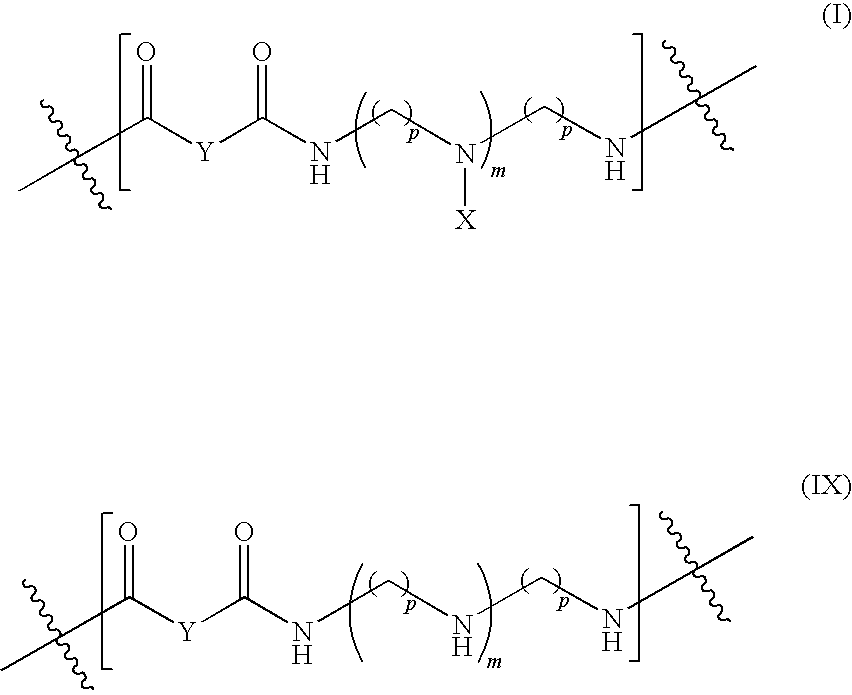Hydrophobically Modified Poly(aminoamides)
a technology of hydrophobic modification and polyamide, applied in the field of watersoluble poly (aminoamide)-based polymers, can solve the problems of reducing the efficiency of the process, accumulating contaminants, and affecting the effect of the process,
- Summary
- Abstract
- Description
- Claims
- Application Information
AI Technical Summary
Problems solved by technology
Method used
Image
Examples
example 1
Alkyl Glycidyl Ether (C12) Modified Poly(Aminoamides)
[0069]Diethylene triamine (103.7 g, 1.005 mole) was charged to a reaction flask equipped with a mechanical agitator, thermocouple, reflux condenser linked with a Dean Stark trap, nitrogen inlet, and addition ports. The reagent was heated at 70° C. and adipic acid (176.1 g, 1.0 mole) was charged to the reaction flask and the contents were mixed for 3 hours at 170° C. Water produced during the condensation polymerization was collected by the Dean Stark trap. The contents were cooled to 130° C. and C1-2 alkyl glycidyl ether (Epodil® 748, Air Products and Chemicals, Inc., Allentown, Pa., 25.8 g, 10 mole % based on the moles of amine used) was charged over 5 minutes. The resulting mixture was stirred at 130° C. for 2 hours. After reaction, the materials were diluted in water, the pH adjusted with 20 wt % aqueous HCl, and mixed until homogenous to yield a 20 wt % solids solution with a pH of 7.0. The Brookfield viscosity of the resultin...
examples 2 through 4
[0070]Examples 2, 3 and 4 were prepared as described in Example 1 except varying amounts of C1-2 alkyl glycidyl ether (Epodil® 748, Air Products and Chemicals, Inc., Allentown, Pa.), 12.9 g (5 mole % based on the moles of amine used), 32.3 g (12.5 mole % based on the moles of amine used) and 38.7 g (15 mole % based on the moles of amine used), were used in the synthesis, respectively
example 5
Alkyl Glycidyl Ether (C8-C10) Modified Poly(Aminoamides)
[0071]Diethylene triamine (103.7 g, 1.005 mole) was charged to a reaction flask equipped with a mechanical agitator, thermocouple, reflux condenser linked with a Dean Stark trap, nitrogen inlet, and addition ports. The reagent was heated at 70° C. and adipic acid (176.1 g, 1.0 mole) was charged to the reaction flask and the contents were mixed for 4 hours at 180° C. Water produced during the condensation polymerization was collected by the Dean Stark trap. The contents were cooled to 130° C. and C9 alkyl glycidyl ether (Epodil®747, Air Products and Chemicals, Inc., Allentown, Pa., 25.8 g, 21.6 g, 10 mole % based on the moles of amine used) was charged in 5 minutes. The resulting mixture was stirred at 130° C. for 2 hours. After reaction, the materials were diluted in water, the pH was adjusted with concentrated H2SO4, and was mixed until homogenous to yield a 35 wt % solids solution with a pH of 7.0. The Brookfield viscosity of...
PUM
| Property | Measurement | Unit |
|---|---|---|
| molecular weight | aaaaa | aaaaa |
| molecular weight | aaaaa | aaaaa |
| molecular weight | aaaaa | aaaaa |
Abstract
Description
Claims
Application Information
 Login to View More
Login to View More - R&D
- Intellectual Property
- Life Sciences
- Materials
- Tech Scout
- Unparalleled Data Quality
- Higher Quality Content
- 60% Fewer Hallucinations
Browse by: Latest US Patents, China's latest patents, Technical Efficacy Thesaurus, Application Domain, Technology Topic, Popular Technical Reports.
© 2025 PatSnap. All rights reserved.Legal|Privacy policy|Modern Slavery Act Transparency Statement|Sitemap|About US| Contact US: help@patsnap.com



